but then I saw her case …
… and now I’m a believer

It may have started a lot earlier, but the immediately preceding events, which led up to the present condition, started with ↵that keyboard. My enthusiasm never broke, and then TK reminded me, that, as university staff, I get a heavy discount at Apple. The dam broke in the middle of the night between Sunday and Monday last week—I ordered a MacBook online. On Tuesday it was here. After having carried it home I switched it on and everything worked like a charm. Except that I could not connect the machine to my wireless network. There was no problem hooking the MacBook up with the modem via Ethernet cable, but it refused to connect wirelessly, although all my three other currently running machines did so. Moreover, just a week earlier a visitor had connected her MacBook without problems. Research on the Web unearthed the problem: MacBooks with Core 2 Duo Intel CPUs can not work together with the wireless router my ISP provided me with. The ISP naturally does not manufacture hardware itself, but buys devices and rebrands them. The ISP’s website is all marketing mumbo-jumbo and gives you no clue about the router itself. The router’s software does, though, and the Web’s vast valleys did the rest, as I learned from there that the Taiwanese manufacturer will not release firmware for my router any more. That was enough for me, on Saturday I went downtown and bought an Airport Extreme base station. It was a matter of minutes to set it up—despite of ↵the mess I have to maintain. Every machine I own, from the oldest notebook up to the new MacBook, flawlessly connects, everything is way faster and the signal is absolutely stable. I have taken a bite of the Apple, have converted and am a sincere believer now.
21st century man
It left her [US Robots’ Chief Robopsychologist Dr. ↑Susan Calvin] unmoved. ‘It merely seems so, Professor Ninheimer. It is only by being concerned for robots that one can truly be concerned for twenty-first-century man. You would understand this if you were a roboticist.’
‘I have read enough ↵robotics to know I don’t want to be a roboticist!’
‘Pardon me, you have read a book on robotics. It has taught you nothing. […]’ (Asimov 1995 [1957]: 423) [bold emphasis mine]
robots and suicide bombing
a bizarre relationship in a decidedly cyberpunked world
On Monday, 4 February 2008 in a shopping mall in Dimona, southern Israel, a “woman has been killed in a suicide bombing […], the first such attack by Palestinian militants in over a year,” ↑reported the BBC. Very sad and tragical (absolutely no irony or cynicism here), as the most of what I heard from the Middle East via the traditional mass media as far as my memory reaches back.
The relationship between robots and human beings has become an issue spawning quite some media attention recently. In Japan robots are used to care for the elderly, are admired for ↵playing musical instruments, and David Levy writes about
“↑Love and sex with robots“ (2008), and makes “the controversial argument that we are headed inexorably towards a society where human affection and human desire are extended into psychological and physical relationships with robots.” Well, there already are “physical relationships with robots”—those of the darker, dystopian, cyberpunkish kind.
In the wake of my trying to show the central relevance of the cyberpunk genre for interpreting and understanding our contemporary world, what strikes me most is, what happened after the explosives at Dimona had detonated, when ↑the cleaner had been called in.

A remote controlled bomb disposal robot was deployed to check ground zero for unexploded ordnance (UXO). The machine inspected the debris around the dead corpse of the alleged bomber, then turned its attention to the man himself and removed the deceased’s jacket by means of its articulate arm. Having unveiled nothing dangerous, the robot went on to the ultimate test …
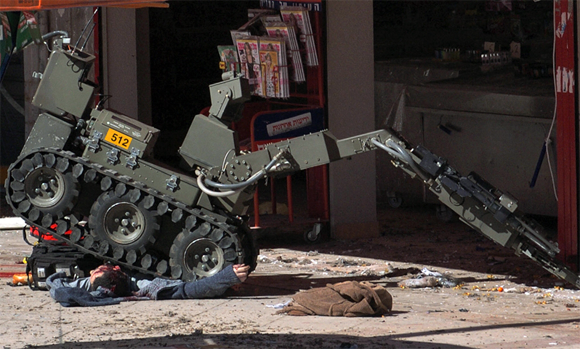
… rolling “over the body of the purported bomber, in a final attempt to be sure there are no more explosives on his person.”

After having mangled the body to satisfaction, Nr 512 returned to investigating and securing the perimeter. Note the blood on the ground, smeared about by the robot’s crawler tracks.
Allow me a bit of twisted thinking … the “mindsets” of both “entities” in the pictures, the man on the ground, and the robot upon him, are very much alike—or were very much alike, when the man was still alive. Neither of them has any respect for human life, and both are more than ready to risk their very own complete destruction. The irony is, that the technological history of the phenotype of today’s bomb disposal robots, like the pictured one, started out with machines, remote controlled by command cable, which were sent on the same kind of missions as the dead man was … transporting explosives into the midst of the enemy and then self-destruct:
The ↑Goliath tracked mine was an unmanned German-engineered demolition vehicle. Employed by the Wehrmacht during World War II, this caterpillar-tracked vehicle was approximately four feet long, two wide, and one tall. It carried 75–100 kg (165–220 lb) of high explosives and was intended to be used for multiple purposes, such as destroying tanks, disrupting dense infantry formations, and demolition of buildings. […] The vehicle was steered remotely via a joystick control box, which itself was attached to the Goliath by a triple-strand telephone cable connected to the rear of the vehicle. Each Goliath was disposable, being intended to be blown up with its target. […] However, the Goliath did help lay the foundation for post-WW2 advances in remote-controlled vehicle technologies.
Against my interpretation of the robot’s actions at Dimona as a “physical interaction between robots and humans,” you might argue, that the robot “only” dealt with a dead corpse. Right so, but bomb disposal robots are also dealing with alive humans. On 8 May 2002 ↑BBC reported, that “Israeli police sappers were called out to a bus stop at the Megido Junction near Haifa after a man was injured in what appeared to be a botched suicide bomb attack.”

With the help of a bomb disposal robot, they turned the man around to inspect his body for remaining explosives. The sappers initially thought the suspect, who appears to have been targeting Israeli soldiers, was dead. The robot’s arm gripped the man and dragged him into the centre of the road, when he began to show signs of life.
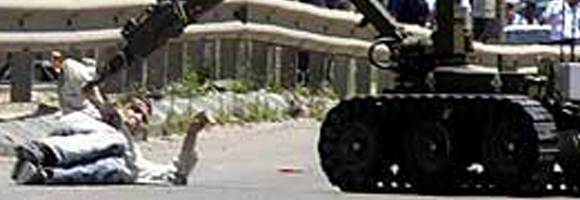
The area, about 20 km (12 miles) from Haifa, was sealed off by police as the robot checked the suspect. The robot used was British and was first designed to inspect suspect devices in Northern Ireland. [emphasis mine]
Now you might say, that all this is not that dramatic, as we are speaking about bomb disposal robots, machines which were not designed to kill, but, quite to the contrary, are used to prevent casualties. Yes, but there are other specimen on duty already. On 02 August 2007 ↑Wired’s Danger Room reported:
Robots have been roaming the streets of Iraq, since shortly after the war began. Now, for the first time—the first time in any warzone—the machines are carrying guns.
After years of development, three “special weapons observation remote reconnaissance direct action system” (SWORDS) robots have deployed to Iraq, armed with M249 machine guns. The ‘bots “haven’t fired their weapons yet,” Michael Zecca, the SWORDS program manager, tells DANGER ROOM. “But that’ll be happening soon.”
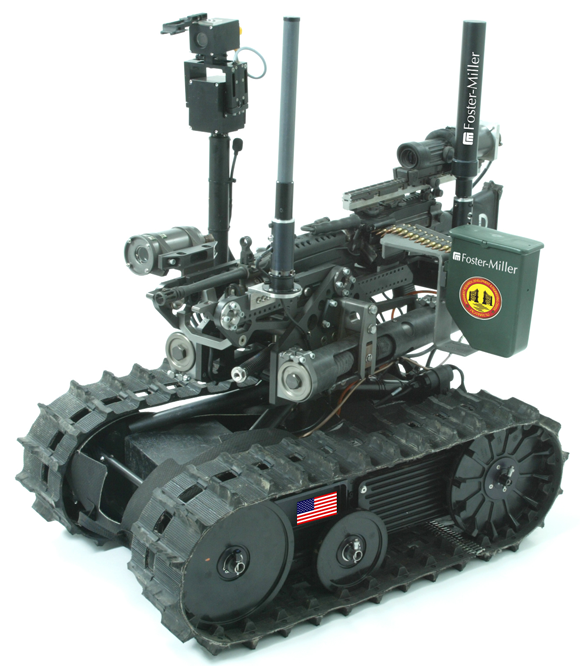
The SWORDS—modified versions of bomb-disposal robots used throughout Iraq—were first declared ready for duty back in 2004. But concerns about safety kept the robots from being sent over to the battlefield. The machines had a tendency to spin out of control from time to time. [emphasis mine]
All in all ↑more than 400 robots did duty in Iraq in 2007. Most of them seem to have been unarmed, though, and were used for …

Now you might object, that all my talking of “robots dealing with” is misleading, as all the above machines are remote controlled, hence the reported cases have to be seen as mediated human action. Nr 512, on duty in Israel, is not alive in the end. Well, meet the “Goalkeeper,” which is in use on British and Netherlandian navy ships, and is exported to South Korea and others …

↑Goalkeeper is a Dutch close-in weapon system, which defends ships against incoming missiles and ballistic shells. The system consists of an autocannon and an advanced radar which tracks incoming fire, determines its trajectory, then aims the gun and fires in a matter of seconds. The system is fully automatic, needing no human input once activated. [emphasis mine]
The mentioned autocannon, with which the “Goalkeeper” is equipped, is a ↑GAU-8 Avenger, a seven-barrell Gatling gun, caliber 30 x 173 mm, firing at 3900 to 4200 rounds per minute. Just in order to get an idea of what we are dealing with, here is a size comparison picture:

Now you might remark, that this is all very impressive, but that the autonomous machine shoots on other machines—airborne ordnance in this case. So let us go full circle and return to where this little essay started, to Israel, to the Gaza border fence, to be precise, where the ↑Samson RCWS (Remote Controlled Weapon Stations) by ↑Rafael Advanced Defense Systems Ltd. are put to use:
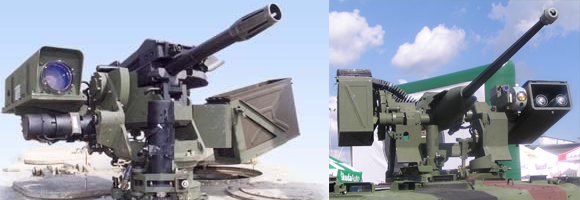
↑For years and years, the Israeli military has been trying to figure out a way to keep Palestinian militants in the Gaza Strip from crossing over into Israel proper. The latest tactic: create a set of “automated kill zones” by networking together remote-controlled machine guns, ground sensors, and drones along the 60-kilometer border. […]
Once IDF sensors locate a potential target, the operator can cue Sentry Tech to verify or engage the target through its own electro-optic (EO) day/night sensor package. The sensor-acquired information is transferred to the electro-optic package of the weapon station, which slews to the target, enabling the operator to locate and track the target… Each Sentry Tech can cover another in the event of a system failure and a single [center] can control up to 15 weapon stations.
↑The idea, ultimately, is to have a “closed-loop” system—↵no human intervention required.
As this is a globalized world, let us look at the other side of it, too:
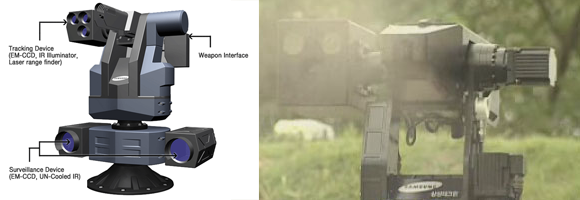
↑A new gun-toting sentry robot, developed by Samsung Techwin Co. for the South Korean government, may soon be coming to a disputed border near you. The ↑SGR-A1 [Security Guard Robot] robot uses a low-light camera and pattern recognition software to distinguish humans from animals or other objects and, if necessary, can fire its built-in machine gun—a Daewoo K3. […]
Should [the Samsung robot] detect an intruder, “the ultimate decision about shooting should be made by a human, not the robot,” says [Myung Ho] Yoo, who led the team that designed the robot. But the robot does have an automatic mode, in which it can make the decision. [emphasis mine]
the cyberpunk educator

Andrew J. Holden’s “↑The Cyberpunk Educator“ is “a documentary study of mainstream ‘cyberpunk’ films of the 1980’s- with a heavy focus on their literary, political, and cultural content. The film uses the structure of literary theorist Northrop Frye, and the cultural critiques of renowned anthropologist Michel Foucault to describe the common, repeating stories in Western culture, and their application to the political process. Though it’s an academic film, its also film about existentialist robots with guns, and it’s fun to watch.” … and it is free for download.
sterling before and after westphalia

↑Bruce Sterling currently is jotting down ↑notes for a projected science fiction novel—maybe we again can, ↵like ↵before, witness a novel by a cyberpunk legend grow online. As a first Sterling published a list of political entities, plus according structuring principles and asked his readers: “Lemme know if you can think of more of these. Especially something that could plausibly replace the ↑Westphalian system, somewhere in the 21st century, without anybody much noticing.” Meanwhile he has recieved some ↑reader comments on ‘after westphalia’—now I have to make a new t-shirt for my “↑Second Life“ (SL) avatar, reading: “↑John Romero and Bruce Sterling ↵talked to me!”
nine per cent
‘Tis a strange realm, cyberspace. Since a couple of years here at ↑Ludwig-Maximilians-Universität München (LMU), the institution where I am working—or am pretending to do so, there is a lot of talk about the university’s corporate identity, its profile, its international publicity, and so on. Well, you people up there, treat me well if you care about the international reputation of our house. Treating me well starts with calling me Mr. Nine Per Cent [not to be confused with ↑50 Cent] from now on … here is a snippet from alexa.com’s ↑traffic statistics for the domain lmu.de. The cumulated “Where people go on Lmu.de” top ten until today [I inserted the hyperlinks to grant the other poor chaps at least some more hits]:
23% ↑ifi.lmu.de—Computer Science
23% ↑campus.lmu.de—Online Services for Students
09% xirdal.lmu.de—Mr. Nine Per Cent
08% ↑ifkw.lmu.de—Communication Science
04% ↑psy.lmu.de—Psychology
04% ↑vwl.lmu.de—Economics
04% ↑edu.lmu.de—Education Science
03% ↑vr.lmu.de—Virtual tour around LMU
02% ↑physik.lmu.de—Physics
02% ↑jobline.lmu.de—Job Application Training Programme
Ain’t that funny? I mean, my domain is hit by more than twice the traffic the domains of the Department for Psychology or the Faculty for Economics has. Even more astounding, onlinewise the mighty Physics Faculty is more than four times my minor ;-) Ah, by the way, campus.lmu.de does not count, as the students are logging in there in order to collect their e-mail—so I am only ↑pwned by them computer geeks … who generate the traffic on their domain thyselves, I presume.
bounded vision
abstract:
A vision is an indispensable precondition to take creative action; it is the source of inspiration. In this paper I want to reflect critically to what degree the designer’s vision is bound. Furthermore I explore the relationship between the designer’s vision and the user’s actual employment of the designed good.
esports conference
nazgûl of armonk

I was startled to hear the thundering of hooves. Having lived near Armonk, NY all my life, I had never heard such a sound before.
“What is that horrible sound?”
“That is the sound of the Black Steeds riding west from Armonk.”
“The Black Steeds?”
“The ↑Nazgul. They once were men. Now they are neither dead nor alive.
They are IBM’s attorneys.”




